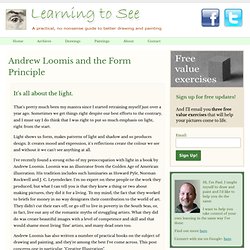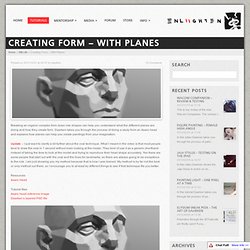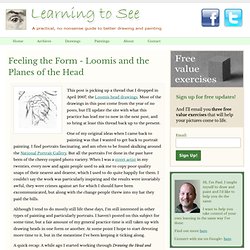

Halfway-to-Black Head. Andrew Loomis and the Form Principle. It's all about the light.

That's pretty much been my mantra since I started retraining myself just over a year ago. Sometimes we get things right despite our best efforts to the contrary, and I must say I do think that I was right to put so much emphasis on light, right from the start. Light shows us form, makes patterns of light and shadow and so produces design. It creates mood and expression, it's reflections create the colour we see and without it we can't see anything at all. I've recently found a strong echo of my preoccupation with light in a book by Andrew Loomis. Andrew Loomis has also written a number of practical books on the subject of drawing and painting, and they're among the best I've come across. In this book, Loomis talks about something he calls the 'Form Principle', which he takes as the basis of an approach to drawing and painting which he uses throughout the book.
I'm not going to attempt a translation into my own words of Loomis' form principle. Enough rambling. Blending – With Pen Pressure – Enliighten. Creating Form – With Planes – Enliighten. Breaking an organic complex form down into shapes can help you understand what the different planes are doing and how they create form.

Daarken takes you through the process of doing a study from an Asaro head and explains how planes can help you create paintings from your imagination. Update – I just want to clarify a bit further about the oval technique. What I meant in the video is that most people tend to draw the oval in 1 second without even looking at the model. They kind of use it as a generic shorthand instead of taking the time to look at the model and trying to reproduce their head shape accurately. Yes there are some people that start out with the oval and the lines for landmarks, so there are always going to be exceptions to the rule. ResourcesAsaro Head Tutorial filesAsaro head reference imageDaarken’s layered PSD file. Planes of the Head with Loomis - Feeling the Form.
This post is picking up a thread that I dropped in April 2007, the Loomis head drawings.

Most of the drawings in this post come from the year of no posts, but I'll update the site with what this practice has lead me to now in the next post, and so bring at least this thread back up to the present. One of my original ideas when I came back to painting was that I wanted to get back to portrait painting. I find portraits fascinating, and am often to be found skulking around the National Portrait Gallery. But all the portraits I've done in the past have been of the cheesy copied photo variety. When I was a street artist in my twenties, every now and again people used to ask me to copy poor quality snaps of their nearest and dearest, which I used to do quite happily for them. Although I tend to do mostly still life these days, I'm still interested in other types of painting and particularly portraits.
Working from imagination is a useful skill no doubt. Here's a photo of the Asaro head. Adv Digital Painting: Rendering Assignments. Scott Robertson Value Exercise. Shading Approach For Digital Painting. 120, 232-235: Light and Shadow by. Damascus5 on deviantART. Rendering: from block in to blending.